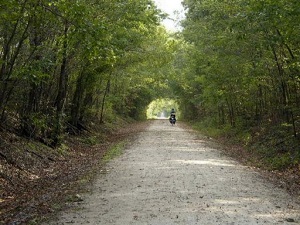Trails across the United States help connect people to nature, inspire healthy activities, and by their very nature, help protect natural places - making communities more livable and connected.
Recently there has been a lot of chatter about accessible trails and coming regulations. Maybe you’ve heard about it, maybe you haven’t. Either way, since we all strive to ensure all people have access to the benefits of parks and recreation, like trails, it is critically important to be aware of what is currently in place around trails accessibility and what’s to come in the next few years.
Accessibility expert, John McGovern, J.D., authors this two-part blog series on accessible trails. In this first part, he clears up the confusion about what is currently a requirement at this point in time. In part two, he’ll explore the evolving requirements and what you need to know.
There has been a lot of discussion about what makes a trail accessible for people with disabilities. Unfortunately, there is not today a final and enforceable standard for trails.
However, there is a lot of guidance.
It is important to note that States, cities, counties, and other jurisdictions may adopt an access requirement that is not yet in a final and enforceable federal Standard.

Become familiar with current ADA standards and coming regulations as it relates to trails
Has your state done so? If so, you already have a requirement to meet.
In addition some funders, such as Department of Transportation, may impose requirements when awarding grants and these requirements may not yet be in a design Standard.
Evaluating compliance? Ask these questions.
It is difficult to find a word that is neutral in discussing common recreation elements such as trails. We will use the word “path” as a catch-all that can include sidewalks, trails, accessible routes, shared use paths, and outdoor recreation accessible routes.
When evaluating the compliance of a path, it is important to determine what type of path it is.
Ask these questions regarding the path:
1. Where is the path located?
2. Is it meant for transportation or for recreation?
3. For what types of activities is the path designed and intended to have occur?
Once these questions are answered and you know what type of path you are evaluating, then you can determine the accessibility guidelines for that particular type of path. For this blog we’ll talk about accessible routes, which is the only path with currently enforceable requirements.
The 2010 Standards for Accessible Design includes requirements for an accessible route. The requirements for an accessible route cover components such as walking surfaces, doors, ramps, curb ramps, elevators, and lifts. Accessible routes are required in 206.2.1 to connect site arrival points to the accessible building or facility entrance. They are also required by 206.2.2 to connect accessible buildings, facilities, elements, and spaces within that site. It is important to note that while the 2010 Standards does include many recreation elements, it does not include trails or shared-use paths.
All other types - shared use paths, trails, pedestrian access routes, and outdoor recreation accessible routes - have detailed design guidance, but that guidance is not yet an enforceable standard.
In Part Two of this blog post, we’ll go into more detail about those coming standards, such as PROWAG (yes, we’ll explain what that is), guidelines for outdoor developed areas, and other guidance you may encounter as it relates to trails and recreation.
What questions do you have about accessible routes? How about trails and accessibility? Share your thoughts or questions in the comments below.

